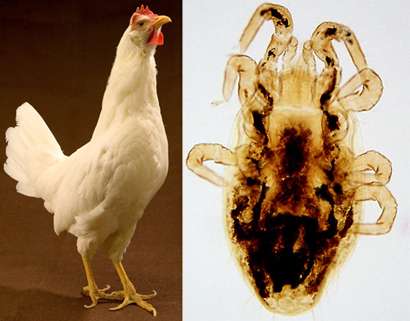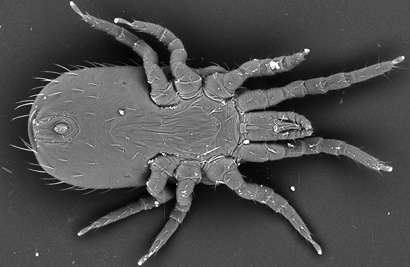Dust baths and longer beaks can make cage-free chickens into mite-free chickens

Life is improving for America's chickens. Due to consumers' increasing interest in animal welfare, large portions of the poultry industry are shifting towards less restrictive housing. Many poultry farmers are replacing the conventional conjoined small wire cages, called "battery cages," with cage-free housing in large open poultry houses. Cage-free housing gives chickens freedom to walk around, spread their wings, and lay their eggs in real nest boxes. But life in this improved housing isn't just sweeter for the chicken, it may also be sweeter for the chicken's ectoparasites.
Most of the methods that commercial poultry farmers use to control mites, lice, and other ectoparasites on their birds were designed with battery cages in mind. Chickens in battery cages can be sprayed with insecticides through the wire walls of the cage, so they do not need to be handled individually. On the other hand, the solid floors and nest boxes available in cage-free housing make life more comfortable for chickens, but they also provide places for parasites like the chicken mite (Dermanyssus gallinae) to hide, as well as organic debris where larvae of sticktight fleas (Echidnophaga gallinacea) can develop.
The challenge is to find ways to control ectoparasites effectively in cage-free environments. In the most recent issue of the Journal of Economic Entomology, researchers Amy Murillo and Bradley Mullens of the University of California, Riverside test whether providing cage-free chickens with dust baths containing a diatomaceous-earth mixture can effectively control one of the most common poultry ectoparasites—the northern fowl mite (Ornithonyssus sylviarum.)
Northern fowl mites are not simply an itchy nuisance for chickens. Mite infestations have economic consequences for poultry. Stress due to mites can reduce egg laying by 10-15 percent, and severe infestations can reduce weight gain in birds raised for meat.
Dust bathing is a natural behavior that chickens and many other species of birds use to remove excess oils and to dislodge parasites from their feathers. To dust bathe, chickens typically scratch a shallow depression in the dirt, squat down in it, and use their wings to fling the dirt or dust up into their fluffed feathers. Many chicken keepers, both hobbyists and commercial producers, will provide chickens with a shallow box filled with sand and other dusty materials specifically for this purpose.
Diatomaceous earth (DE) is actually a sedimentary rock made up of fossilized algae called diatoms. DE crumbles easily into a fine powder and has many commercial uses, for instance as a mild abrasive in toothpaste. This same abrasive action makes it an effective insecticide. Most terrestrial arthropods, including mites, have a waxy coating on the surface of their exoskeletons. This wax helps them maintain their internal water balance. DE scrapes off and absorbs this surface wax, and without it the wax, mites die of desiccation.

The idea of adding DE to a chicken's dust bath is not new; backyard chicken keepers routinely use the product for parasite control. Murillo and Mullens wanted to see if it would be effective on a larger, commercial-poultry-production scale. They housed experimental flocks of mite-free chickens in cage-free poultry houses and provided them with dust baths containing DE mixed with sand. They then put 20-30 northern fowl mites on each hen and monitored mite populations. Would the dust baths prevent the mites from establishing populations large enough to cause damage? After several weeks, they removed the dust baths from half the flocks and continued to monitor mites.
When chickens had access to dust baths, mite populations increased, but slowly. Infestation severity remained below the threshold at which it has significant effects on hens' egg laying and weight gain. In flocks where dust baths were removed, mite populations increased—in most cases to economically damaging levels.
Murillo and Mullens also investigated how chickens' beak condition affected mite populations. Commercial chicken producers routinely trim the end of birds' beaks off when they are young chicks. This prevents cannibalism—chicks aren't always innocent balls of fluff—and feather pecking.
A newer method of beak trimming, using an "infra-red trimmer," leaves more of the chickens' beaks intact, allowing the birds to groom themselves more effectively. The researchers found that chickens with intact beaks had fewer mites, even when they were not provided with dust baths. When these same birds were provided with dust baths containing DE, they were reliably able to keep mite populations below economically damaging levels.
"Ectoparasite problems are not going to decrease in cage-free or free-range poultry, but we can try to be as proactive as possible when it comes to managing pest problems," said Murillo. "There needs to be a balance between keeping chickens healthy (disease and parasite free) while allowing for natural behaviors and increased welfare. As an entomologist, I can work to find better solutions for pest management that will work in these new systems without compromising animal welfare."
Indeed, dust bathing seems to make the chickens happy—or at least they seem very eager to do it. According to Murillo, the chickens would crowd around the dust bath as she was refilling it, like eager children waiting for the kiddie pool to fill. As soon as she was done, one or two birds would hop right in.
It seems the answer to controlling poultry ectoparasites in commercial, cage-free housing is to let chickens be chickens. Their natural dust bathing and grooming behaviors are effective at removing northern fowl mites—especially if beak trimming is minimized and birds are provided with dust baths containing diatomaceous earth mixtures. If cage-free poultry producers adopt this method, commercially-raised birds, not just pampered pet chickens, will be able to enjoy a soothing "dusting of diatoms."
More information: Amy C. Murillo et al. Timing Diatomaceous Earth-Filled Dustbox Use for Management of Northern Fowl Mites (Acari: Macronyssidae) in Cage-Free Poultry Systems, Journal of Economic Entomology (2016). DOI: 10.1093/jee/tow165
Journal information: Journal of Economic Entomology
Provided by Entomological Society of America





















